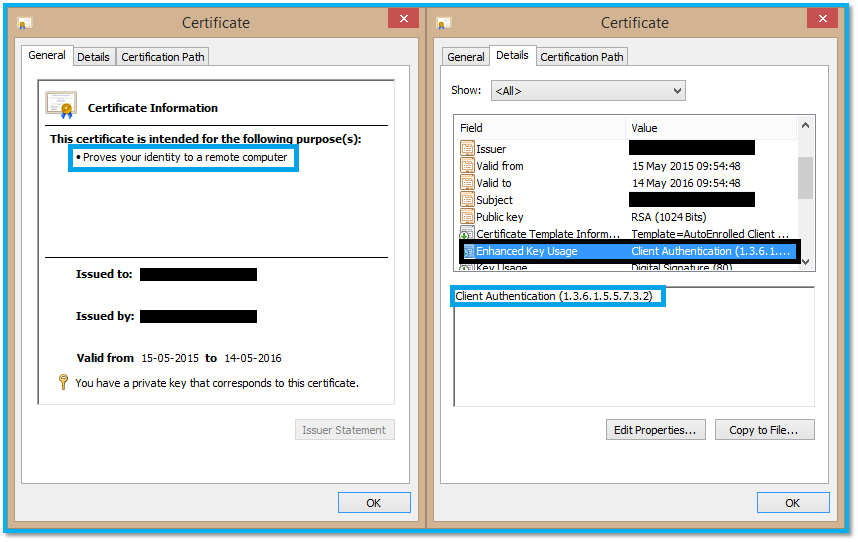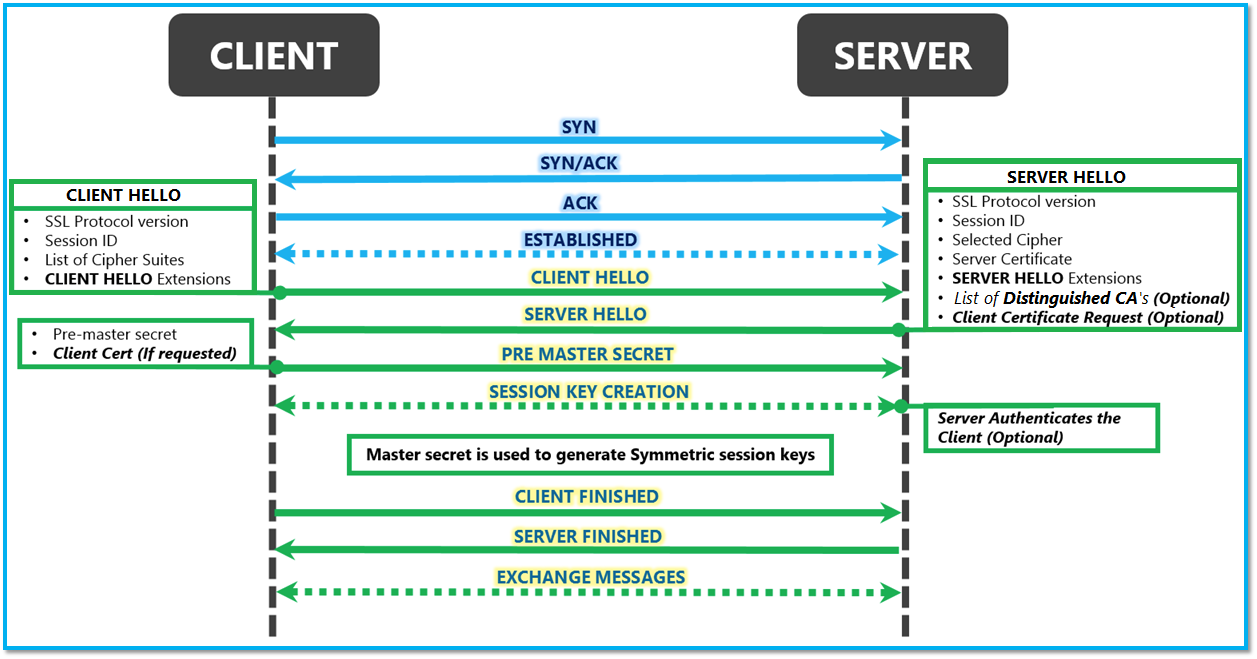Note
Access to this page requires authorization. You can try signing in or changing directories.
Access to this page requires authorization. You can try changing directories.
SSL/TLS certificates are commonly used for both encryption and identification of the parties. In this blog post, I'll be describing Client Certificate Authentication in brief.
Client Certificate Authentication is a mutual certificate based authentication, where the client provides its Client Certificate to the Server to prove its identity. This happens as a part of the SSL Handshake (it is optional).
Before we proceed further, we need to understand
- What is a client certificate?
- What is authentication & why do we need it?
| Client Certificates |
Client Certificate is a digital certificate which confirms to the X.509 system. It is used by client systems to prove their identity to the remote server. Here is a simple way to identify where a certificate is a client certificate or not:
- In the Details tab, the certificates intended purpose has the following text:
"Proves your identity to a remote computer" - Verify that the Enhanced Key Usage field of the certificate has the OID set to (1.3.6.1.5.5.7.3.2) .
Below is a screenshot of a sample Client Certificate:

Refer RFC 5246
| Authentication & Authorization |
In Computer Science, Authentication is a mechanism used to prove the identity of the parties involved in a communication. It verifies that "you are who you say you are". Not to be confused with Authorization, which is to verify that "you are permitted to do what you are trying to do".
There are several types of authentication. Here is a list of authentication widely used on IIS (in no specific order):
- Anonymous Authentication (No Authentication)
- Basic Authentication
- Client Certificate Authentication
- Digest Authentication
- Forms Authentication
- NTLM
- Kerberos
- Smart Card Authentication
| NOTE: As the SSL Handshake happens before HTTP communication, Client Certificate Authentication takes the highest precedence over any other type of authentication that takes place over HTTP protocol. |
Kerberos, Client Certificate Authentication and Smart Card Authentication are examples for mutual authentication mechanisms. Authentication is typically used for access control, where you want to restrict the access to known users. Authorization on the other hand is used to determine the access level/privileges granted to the users.
On Windows, a thread is the basic unit of execution. Any task performed by the user is executed by the thread under the context of a specific account/identity. Authentication is one of the ways used to determine the thread identity, whose privileges will be used by the thread for execution.
| Client Certificate Authentication in SSL/TLS Handshake |
I have already discussed SSL Handshake in one of my blog posts. Browse to:
https://blogs.msdn.com/b/kaushal/archive/2013/08/03/ssl-handshake-and-https-bindings-on-iis.aspx
Here is a screenshot describing the SSL/TLS Handshake:

- Client sends CLIENT HELLO as described in the above image
- Upon receiving the CLIENT HELLO, if the server is configured for Client Certificate Authentication, it will send a list of Distinguished CA names & Client Certificate Request to the client as a part of the SERVER HELLO apart from other details depicted above.
- Upon receiving the Server Hello containing the Client Certificate request & list of Distinguished CA names, the client will perform the following steps:
- The client uses the CA list available in the SERVER HELLO to determine the mutually trusted CA certificates.
- Theclient will then determine the Client Certificates that have been issued by the mutually trusted Certification Authorities.
- The client will then present the client certificate list to the user so that they can select a certificate to be sent to the user.
NOTE:
|
- Upon selection, the client responds with a
- ClientKeyExchange message which contains the Pre-master secret
- Certificate message which contains the Client certificate (Doesn't contain the private key).
- CertificateVerify message, which is used to provide explicit verification of a client certificate. This message is sent only if the Client Certificate message was sent. The client is authenticated by using its private key to sign a hash of all the messages up to this point. The recipient verifies the signature using the public key of the signer, thus ensuring it was signed with the client's private key. Refer RFC 5246 for more details.
- Post this Client & Server use the random numbers and the Pre-Master secret to generate symmetric (or Master) keys which will used for encrypting & decrypting messages for further communication.
- Both respond with ChangeCipherSpec indicating that they have finished the process.
- SSL Handshake stands completed now and both the parties own a copy of the master key which can be used for encryption and decryption.
| Design Problems |
We know that the server sends the list of Distinguished CA names as a part of SERVER HELLO. The RFC never mandates the list of Distinguished CA Names should contain Root CA or Intermediate CA certificates. Here is a snippet of this section defined in the RFC5246:
| certificate_authoritiesA list of the distinguished names [X501] of acceptablecertificate_authorities, represented in DER-encoded format. Thesedistinguished names may specify a desired distinguished name for aroot CA or for a subordinate CA; thus, this message can be used todescribe known roots as well as a desired authorization space. Ifthe certificate_authorities list is empty, then the client MAYsend any certificate of the appropriate ClientCertificateType,unless there is some external arrangement to the contrary |
Refer the below blog post for information on Root & Intermediate CA certificates:
https://blogs.msdn.com/b/kaushal/archive/2013/01/10/self-signed-root-ca-and-intermediate-ca-certificates.aspx
This can lead to a problem where few systems require Root CA's while few require Intermediate CA's to be present in the list sent in the SERVER HELLO. This makes the communicating parties incompatible on certain occasions.
Both the implementations are debatable. On one hand the list sent by the server cannot exceed a certain limit (on windows the size is 12,228 bytes). If exceeded, the auth will fail. The list of Intermediate CA's always exceeds the list of Root CA by 2-3 folds or even higher. This is one of the reasons why some systems send the ROOT CA's in the list of Distinguished CA Names. On the other hand, the Intermediate CA names are readily available in the client certificate provided by the user, so it makes it easier during the certificate chain validation, therefore some systems prefer this over the previous one. Both have their own merits.
One example I have personally encountered is Apple's Safari browser communicating to a site hosted on IIS 7 or higher which requires Client Certificate for authentication. Safari expects a list of Intermediate CA's in the SERVER HELLO. On the other hand, IIS sends only Root CA's in that list. As a result the authentication fails as the client is unable to provide a client certificate to the server.
A solution to the above problem is to configure IIS to not send any the CA list in the SERVER HELLO. To achieve this follow the Method 3 described in the support article below:
https://support.microsoft.com/en-us/kb/933430/
The above article requires you to add a registry key, SendTrustedIssuerList, which is set to 0.
As a result the server doesn't send any list to the client, but requires it to pass a client certificate. The client will present the complete list of client certificates to choose from and it will proceed further as expected.
NOTE: In Windows Server 2012 and Windows 8, changes were made to the underlying authentication process so that:
|
Anonymous
February 23, 2016
Thanks for the great post.Anonymous
March 01, 2016
Thank you for this interesting POST. I'd like to ask for explanation. I am using X.509 certificate, and when I tried to post my data to a webservice which I want to communicate with, I am getting the following error: "No client certificate was presented during SSL Handshake"... can you please explain me what is the issue? Thank youAnonymous
March 18, 2016
GRTAnonymous
August 01, 2016
Hi,Is there any possibility to stablish handshake without sending a list of Distinguished CA? I mean, the client could use any certificate which he has got.Thank you- Anonymous
June 13, 2017
Sorry for the late response. FYI, this is possible. The Server can do this by not sending any list. In Windows this is usually done by enabling the following in the registry.HKEY_LOCAL_MACHINE\SYSTEM\CurrentControlSet\Control\SecurityProviders\SCHANNELValue name: SendTrustedIssuerList Value type: REG_DWORD Value data: 0 (False)
- Anonymous
Anonymous
August 15, 2017
we found a terrible issue where a Safari browser hangs because of this, yet in the background there are a large number or requests being made while the browser just spins. Based on the note above "SendTrustedIssuerList registry key is now 0 (off by default)" I'd not expect a prompt for a client certificate to even happen. BUT it does... does anyone know where I can get support on this issue?